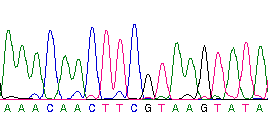DNA sequence

|
WikiDoc Resources for DNA sequence |
|
Articles |
|---|
|
Most recent articles on DNA sequence Most cited articles on DNA sequence |
|
Media |
|
Powerpoint slides on DNA sequence |
|
Evidence Based Medicine |
|
Clinical Trials |
|
Ongoing Trials on DNA sequence at Clinical Trials.gov Clinical Trials on DNA sequence at Google
|
|
Guidelines / Policies / Govt |
|
US National Guidelines Clearinghouse on DNA sequence
|
|
Books |
|
News |
|
Commentary |
|
Definitions |
|
Patient Resources / Community |
|
Patient resources on DNA sequence Discussion groups on DNA sequence Patient Handouts on DNA sequence Directions to Hospitals Treating DNA sequence Risk calculators and risk factors for DNA sequence
|
|
Healthcare Provider Resources |
|
Causes & Risk Factors for DNA sequence |
|
Continuing Medical Education (CME) |
|
International |
|
|
|
Business |
|
Experimental / Informatics |
Editor-In-Chief: C. Michael Gibson, M.S., M.D. [1]
Overview
A DNA sequence or genetic sequence is a succession of letters representing the primary structure of a real or hypothetical DNA molecule or strand, with the capacity to carry information.
The possible letters are A, C, G, and T, representing the four nucleotide subunits of a DNA strand - adenine, cytosine, guanine, thymine bases covalently linked to phospho-backbone. In the typical case, the sequences are printed abutting one another without gaps, as in the sequence AAAGTCTGAC, going from 5' to 3' from left to right. A succession of any number of nucleotides greater than four is liable to be called a sequence. With regard to its biological function, which may depend on context, a sequence may be sense or anti-sense, and either coding or noncoding. DNA sequences can also contain "junk DNA."
Sequences can be derived from the biological raw material through a process called DNA sequencing.
In some special cases, letters besides A, T, C, and G are present in a sequence. These letters represent ambiguity. Of all the molecules sampled, there is more than one kind of nucleotide at that position. The rules of the International Union of Pure and Applied Chemistry (IUPAC) are as follows:
A = adenine
C = cytosine
G = guanine
T = thymine
R = G A (purine)
Y = T C (pyrimidine)
K = G T (keto)
M = A C (amino)
S = G C (strong bonds)
W = A T (weak bonds)
B = G T C (all but A)
D = G A T (all but C)
H = A C T (all but G)
V = G C A (all but T)
N = A G C T (any)
See also
External links
bg:ДНК секвенция cs:Sekvence DNA de:Nukleotidsequenz ko:염기서열 id:Sekuens DNA th:ลำดับดีเอ็นเอ